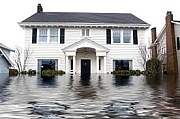Flood and Water Damage
A major set back in the restoration process is the time taken to dry out buildings prior to starting remedial building work. There are potentially hundreds of litres of water that remain hidden within the building’s structure.
As a result, buildings remain unfit for use or occupation for many months during which time high internal humidity levels can cause secondary damage and increase the risk of dangerous mould growths.
Whilst the drying rate of a material will vary according to its porosity and density, it is also determined by the ability of moisture to evaporate into the surrounding air. Drying rates are greatly improved by lowering relative humidity, adding heat and increasing air movement./p>
Dehumidification of flood damaged buildings
The primary benefit of a refrigeration type dehumidifier is that it performs well when used in a warm humid environment. Moisture extraction rates will deteriorate rapidly as both temperature and humidity is reduced. It is generally accepted that refrigeration dehumidifiers should not be used below 10°C dewpoint.
A desiccant dehumidifier operates on a totally different principle to a refrigeration type. The main benefit is that it performs exceptionally well when used in cooler climates, or when lower dew points are required. As there is no water produced during the drying process, these units work effectively at sub-zero temperatures.
Air leaving a desiccant dehumidifier is warm, very dry and at high velocity, thereby providing the three essential ingredients necessary for increasing drying rates. The dry air can be easily ducted to where drying is needed most, whether it is under a floor, into a wall cavity or simply distributed to serve multiple areas.
Whilst the purchase of a desiccant dehumidifier is probably not within the financial budgets of most home owners, some restoration companies now provide small desiccant units for hire. High capacity desiccant dehumidifiers should be used for drying larger buildings such as schools, warehouses, municipal buildings, etc.
